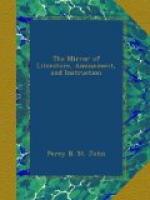* * * * *
HISTORY OF COALS.
(For the Mirror.)
Coals are found in several parts of the continent of Europe, but the principal mines are in this country. They have been discovered and wrought in Newfoundland, Cape Breton, Canada, and in some of the provinces of New England. China abounds in them, and they are well known in Tartary, and in the Island of Madagascar.
We find (says Brand) express mention of coals, used as a fuel by artificers about 2,000 years ago, in the writings of Theophrastus, the scholar of Aristotle, who, in his book on Stones, gives the substance; though some writers have not scrupled to affirm, that coal was unknown to the Ancient Britons, yet others have adduced proofs to the contrary, which seem, to carry along with them little less than conviction. The first charter for the license of digging coals, was granted by King Henry III. in the year 1239; it was there denominated sea coal; and, in 1281, Newcastle was famous for its great trade in this article; but in 1306, the use of sea coal was prohibited at London, by proclamation. Brewers, dyers, and other artificers, who had occasion for great fires, had found their account in substituting our fossil for dry wood and charcoal; but so general was the prejudice against it at that time, that the nobles and commons assembled in parliament, complained against the use thereof as a public nuisance, which was thought to corrupt the air with its smoke and stink. Shortly after this, it was the common fuel at the King’s palace in London; and, in 1325, a trade was opened between France and England, in which corn was imported, and coal exported. Stowe in his “Annals” says, “within thirty years last the nice dames of London would not come into any house or roome where sea coales were burned; nor willingly eat of the meat that was either sod or roasted with sea coal fire.”
Tinmouth Priory had a colliery at Elwick, which in 1330 was let at the yearly rent of five pounds; in 1530 it was let for twenty pounds a year, on condition that not more than twenty chaldron should be drawn in a day; and eight years after, at fifty pounds a year, without restriction on the quantity to be wrought. In Richard the Second’s time, Newcastle coals were sold at Whitby, at three shillings and four-pence per chaldron; and in the time of Henry VIII. their price was twelvepence a chaldron in Newcastle; in London about four shillings, and in France they sold for thirteen nobles per chaldron. Queen Elizabeth obtained a lease of the manors and coal mines of Gateshead and Whickham, which she soon transferred to the Earl of Leicester. He assigned it to his secretary, Sutton, the founder of the Charter-house, who also made assignment of it to Sir W. Riddell and others, for the use of the Mayor and Burgesses of Newcastle. Duties were laid upon this article to assist in building




